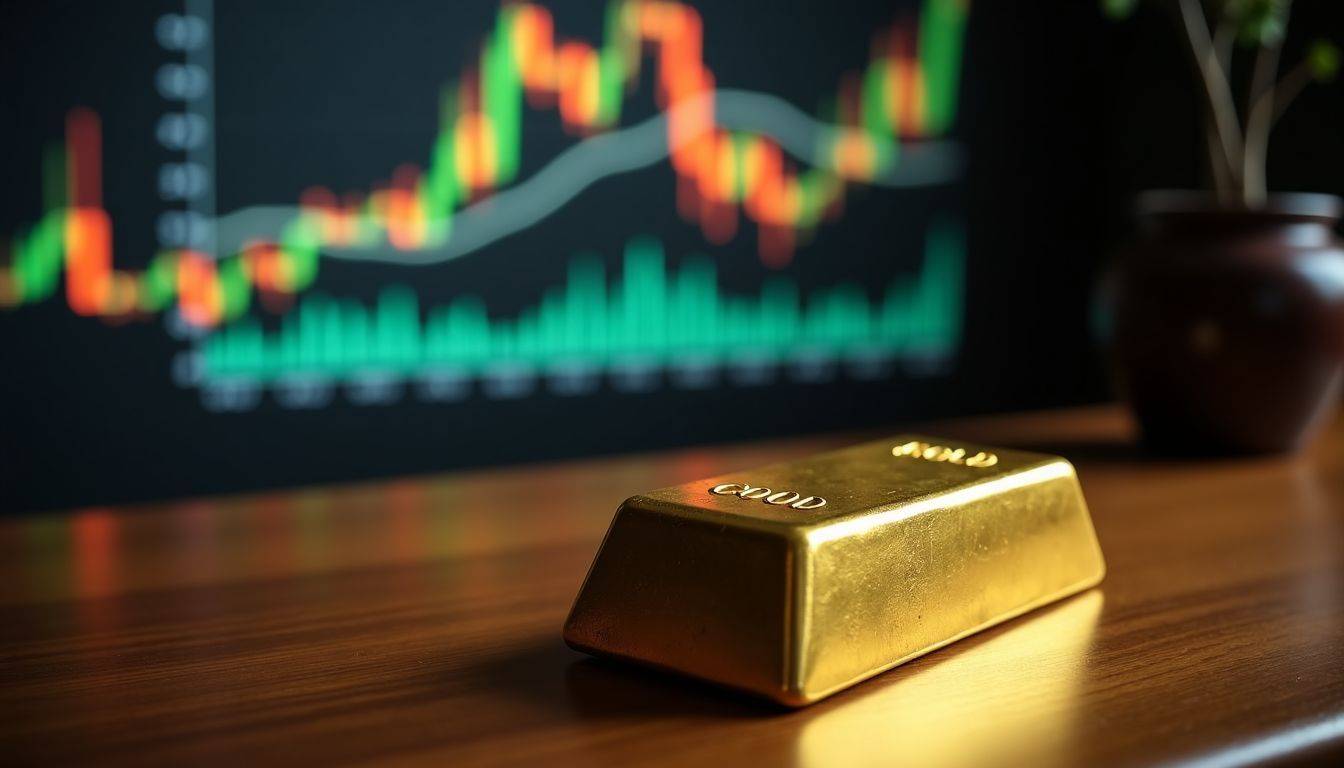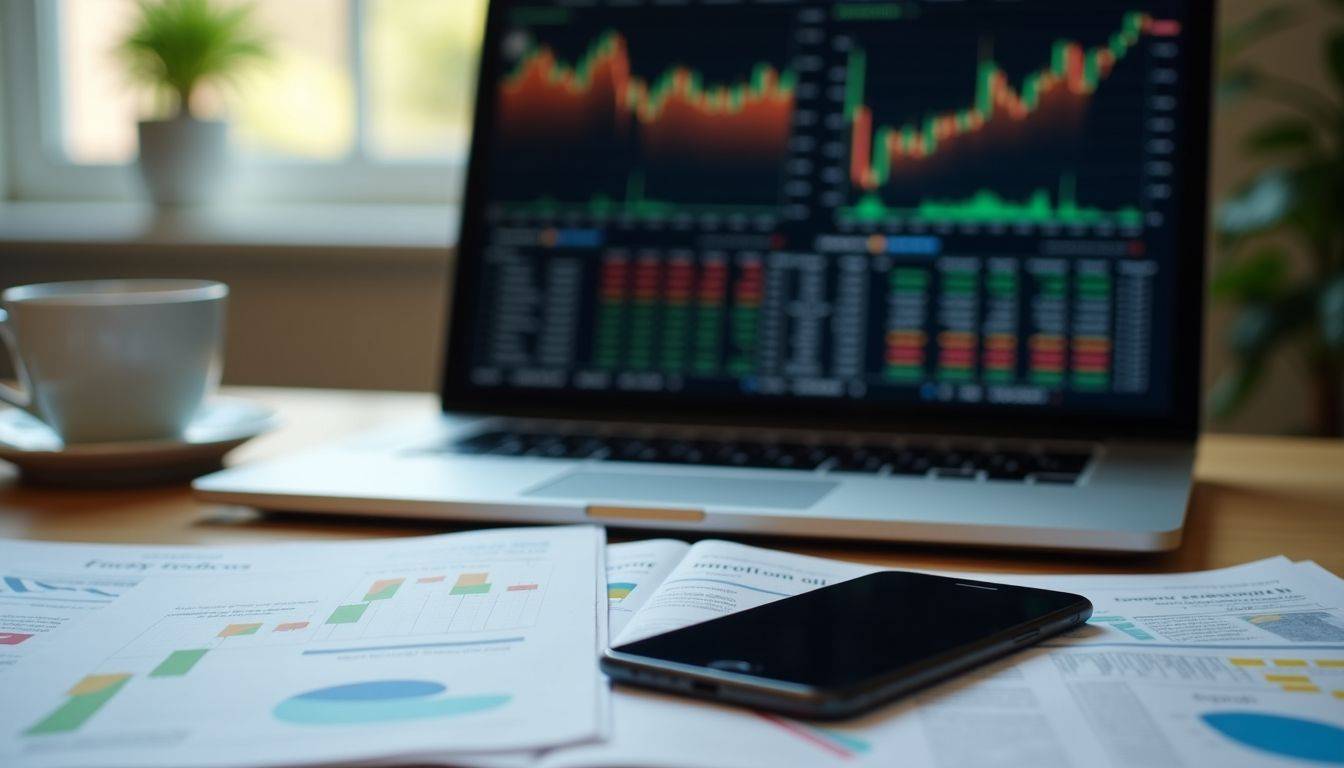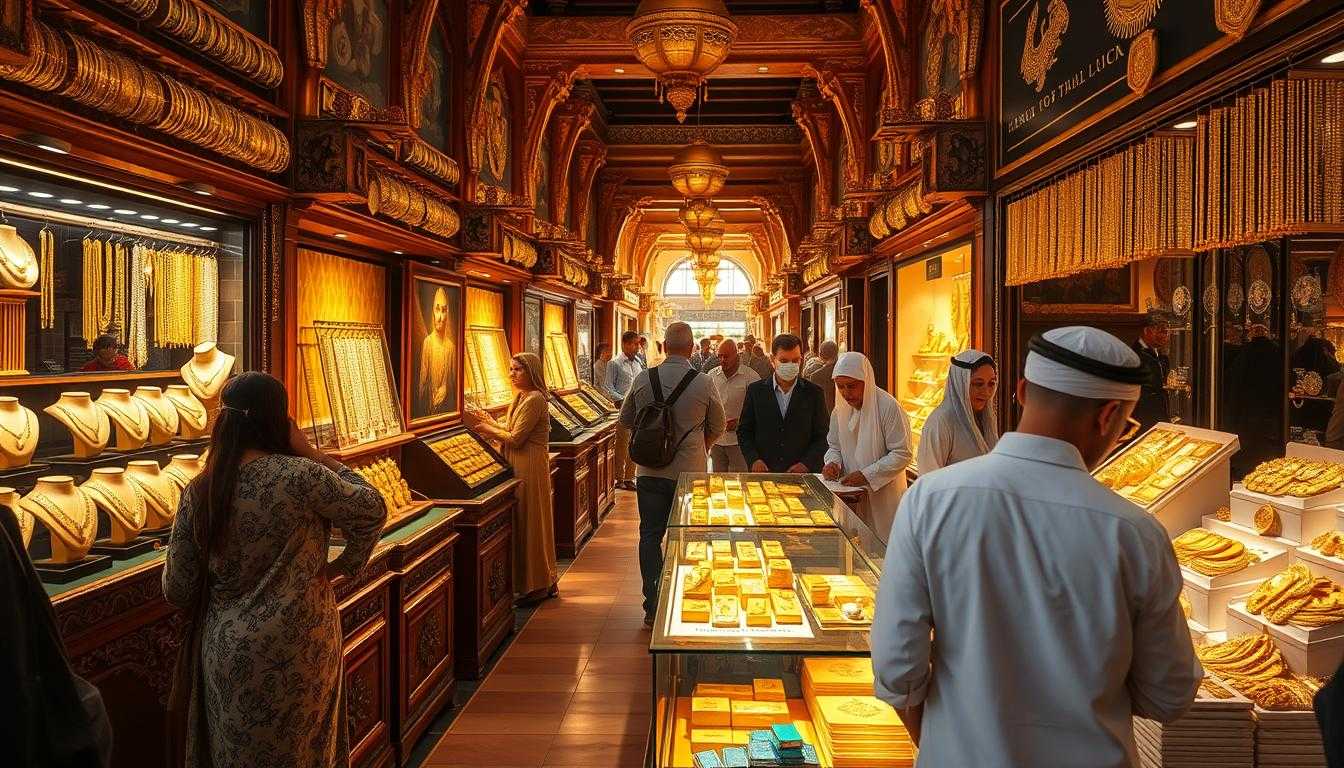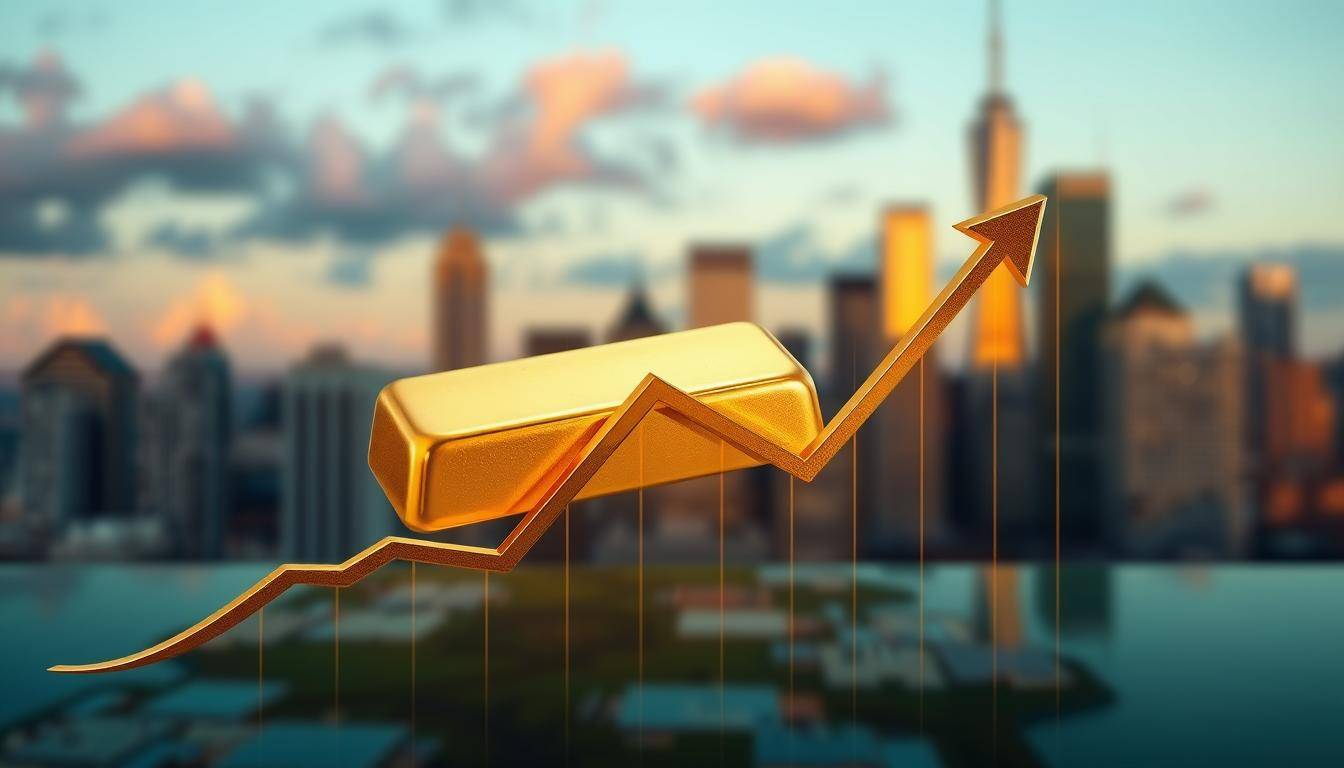Ever felt confused by how gold prices and the stock market seem to dance in opposite directions? You’re not alone. Many folks scratch their heads when they see gold prices shoot up as stock markets take a tumble.
Here’s a fact for you: Gold is often seen as a safe haven during times of economic uncertainty.
This article will shine a light on this curious relationship. We’ll explore why investors flock to precious metals like gold when stocks and bonds start looking shaky. Ready for some insights that could help your wallet? Keep reading!
The Relationship Between Gold Prices And Financial Market Performance

Gold prices and the stock market play a bit of tug-of-war. When stocks fall, gold often shines bright as folks look for a safe place to park their cash.
Gold’s Role as a Safe-Haven Asset
In times of financial trouble, people turn to gold. They see it as a safe place to put their money. This is because, unlike stocks or bonds, gold keeps its value well during economic downturns and market volatility.
For instance, during the 2008 financial crisis, while most of the stock market was losing value fast, the price of gold went up. Investors like using gold bullion and exchange-traded funds (ETFs) as ways to protect their portfolios from big swings in value.
Central banks also play a big role here. They buy lots of gold as part of their reserves. When they think there might be inflation or other kinds of economic trouble ahead, they often buy more gold.
This shows how much central banks trust in gold’s ability to hold its value over time. So for traders and investors looking at long-term safety for their money, investing in physical gold or related assets can make sense.
Inverse Relationship with the Stock Market
So, we see gold shines bright as a safe place to park money. But there’s more to the story with its dance against stock market moves. Gold prices and the Dow Jones Industrial Average often move in opposite directions.
Think of them like two kids on a seesaw; when one goes up, the other tends to go down.
Economic uncertainty typically drives up gold prices while stock prices may fall.
Let’s break it down. Investors flock to gold during times stocks take a hit. It’s their go-to safety net. This action pumps up gold prices. On sunny days in the stock market, though, investors chase those potential gains leaving gold behind.
This switch can cause gold’s price to dip.
Interest rates play a big part too. Lower interest rates make bonds and savings less attractive compared to stocks or even holding onto some shiny metal bars or coins for that matter – yep, I’m talking about gold! Plus, lower rates mean cheaper borrowing costs which can boost spending and investment in the economy pushing up stock prices but not always favoring our glittering friend as much.
Impact of Economic Uncertainty on Gold Prices
Economic uncertainty makes gold more popular. People buy gold when they worry about the stock market or the economy. Gold prices go up because many see it as a safe place to put their money.
This happens during tough times like big market drops or when inflation is high.
Gold and financial markets usually move in opposite ways. When stocks fall, gold often rises. This is because investors look for safer places to keep their money away from risky investments.
They also use gold to protect against losing money due to inflation or currency problems.
Next, let’s talk about what affects both gold prices and how well financial markets do.
Factors Influencing Gold Prices And Financial Market Performance

Gold prices swing up and down like a seesaw. This happens because of things like how much it costs to borrow money, how much stuff costs, and if people are worried about big world problems.
These swings can make or break traders’ days, making keeping an eye on them as exciting as watching a thriller movie – you never know what’s going to happen next!
Interest Rates
Interest rates act as the pulse of the financial world. With upward and downward fluctuations, they impact everything from the cost of securing a loan to gold prices. Here’s an easy interpretation: with an increase in interest rates, individuals are likely to gain increased returns from saving their cash.
Thus, the appeal of gold, which doesn’t offer interest or dividends, might lessen.
Elevated rates also result in more costly loans. Businesses may reduce their expenditure and investment due to higher borrowing costs. This could decelerate economic expansion, causing investor unrest and sometimes directing them to seek refuge in gold for their resources.
Gold radiates splendidly when other investments appear precarious.
Inflation
Inflation makes things cost more over time. This affects how much gold can buy. As prices go up, people start to see gold as a safe place to keep their money. They worry less about losing value in uncertain times.
Gold becomes like a shield against the rising costs of goods and services, making it more popular during high inflation.
Experts say that as the cost of living increases, so does interest in gold. Daily updates on market trends show this change. Knowing about inflation helps traders make smart choices with gold and other investments.
This keeps their money safe when prices are going up fast.
Currency Value
Following inflation, the value of money plays a big part in gold prices and market moves. If the U.S. dollar gets stronger, people can buy more gold with fewer dollars. This makes the price of gold go down.
But if the dollar gets weaker, it takes more to buy the same amount of gold, pushing its price up.
Many traders watch how gold and currencies like the U.S. dollar change over time. A weak dollar often means higher gold prices. It’s a dance between currency values and precious metals that smart investors keep an eye on.
Exchange rates and market sentiment affect this balance too, making it key for diversifying your portfolio or hedging against financial risks in volatile markets.
Geopolitical Events
Gold gleams brightly during challenging times. Consider how a frightening film gathers everyone together, correct? Similarly, geopolitical uncertainties drive gold prices. They motivate individuals to buy more gold as a secure place for their finances, causing gold’s value to rise.
Geopolitical incidents can disturb the entirety of the financial market. They frequently incite substantial changes in global pricing. When nations face conflicts or when there’s unpredictability about future events, investors turn to gold.
It’s similar to having an umbrella when anticipating rain – simply logical.
In times of crisis, gold serves as more than just a safe harbor; it’s a supportive ally.
Navigating Financial Markets with Real-Time Gold Rate Updates

Keeping up with real-time gold rates helps traders make smart choices. This info guides investors through ups and downs in markets.
- Check daily market updates from skilled analysts. They give the latest on gold, Forex, Oil, Indices, and Bitcoin.
- Watch YouTube videos and read blogs for deeper understanding. Experts share tips and insights here.
- Use live gold price charts online. They show how prices change minute by minute.
- Follow news on geopolitical events closely. These often cause big moves in gold prices.
- Keep an eye on the U.S. dollar value. Gold moves opposite to it most times.
- Consider interest rates and inflation news from the Federal Reserve. High rates can lower gold demand.
- Diversify your portfolio with gold investments like coins, bars, or ETFs (Exchange-Traded Funds). This spreads out risk.
- Understand that investing in gold can hedge against market downturns. It’s a safety net when stocks fall.
- Know that central banks buy gold too, affecting its global price.
- Use tools like futures contracts to guess future prices and plan ahead.
11 Allocate parts of your investments in other metals like silver and platinum for more safety.
By staying tuned to these points, traders can navigate the financial markets more smoothly with real-time updates on gold rates.
Interpreting the Relationship for Investment Decisions

Understanding how gold and the stock market interact can help us make better choices with our money. We look at trends, compare them to the economy’s ups and downs, and decide where to put our cash for good results.
Diversification Benefits
Putting gold in your investment mix makes your portfolio stronger. This is because gold acts differently from other things you can invest in, like stocks or bonds. It’s kind of a shield against risks that can make those investments lose value fast.
For example, when prices go up (inflation) or the value of money goes down, gold often keeps its worth. This helps keep your portfolio steady even when the market gets rough.
Gold also gives you more ways to make money across different markets. Let’s say the stock market is not doing well because of high inflation or geopolitical tensions. Often, this makes gold prices go up.
So, having gold as part of what you own means you might still gain even if other parts are losing value. Plus, daily updates on the price of gold help traders and investors act quickly to get the most out of their investments in both calm and stormy times.
Hedging Against Market Downturns
Gold acts like a safety net during stock market drops. Imagine the stock market as a wild roller coaster. Now, think of gold as the steady ground under it. As stocks fall, gold often goes up.
This makes gold a good choice for spreading out risks in your portfolio. It’s like not putting all your eggs in one basket.
Experts say keeping an eye on daily gold prices helps with making smart moves in shaky markets. Blogs and YouTube channels give tips on using gold to protect money when times get tough.
They say diversifying with gold can soften the blow from bad turns in the economy or global politics.
Long-Term Investment Opportunities
Gold can open doors to various long-term investment options. This shiny metal isn’t just about quick gains. It’s a pillar for building a strong, diversified portfolio that stands firm against market shakes and economic twists.
Think about gold IRAs or adding gold exchange-traded funds (ETFs) to your mix. These moves help spread your risks around, so not all your eggs are in one basket.
Seeing the bigger picture, experts suggest keeping an eye on daily market trends but also focusing on how assets like gold can boost long-term success in your investments. Moving forward, understanding these strategies paves the way for savvy decisions in other asset classes too.
Conclusion

We talked about how gold prices and market performance are connected. Gold is a safe place during tough times. Its price goes up when the stock market falls. Things like interest rates and big world events can change gold prices too.
Keeping an eye on gold prices helps in making smart money choices. Think about using gold to spread out your investments or protect against losses.
Gold playing a part in portfolios offers safety nets for investors. It’s wise to look at daily updates on gold rates for better decisions. Reading blogs or watching videos can also give tips on using this knowledge.
Taking steps based on this link between gold and markets could boost your investment game. Look into more resources to keep learning about it.
Let this idea push you to explore and use these strategies in your financial plans.
For more insights on how to effectively navigate the financial markets, check out our guide on real-time gold rate updates.
FAQs
1. What’s the link between gold prices and financial market performance?
Well, it’s all about “flight to safety”. During times of economic contraction or stock market downturns, investors often turn to gold as an investment. It’s seen as a store of value that hedges against inflationary pressures and diversifies portfolios.
2. How does geopolitical uncertainty impact gold prices?
Ah, great question! When geopolitical uncertainty rises – think wars or global pandemics like COVID-19 – investors tend to flock towards safe assets like gold. This drives up its price, even when national currencies are fluctuating.
3. Can central banks influence the price of gold?
Absolutely! Central bank buying can raise the demand for gold (remember your high school economics?). Plus, monetary policy changes like interest rate cuts can also affect its price.
4. Why is there talk about U.S dollars when discussing gold prices?
Gold is generally priced in U.S dollars globally – so any change in the value of the U.S dollar impacts its cost on commodity exchanges. For instance, if our greenback weakens due to Fed rate cuts or hyperinflation fears…gold gets pricier!
5. Does investing in other commodities provide similar benefits as investing in Gold?
Not quite my friend! While commodities like palladium or liquefied natural gas do offer portfolio diversification benefits just like Gold; their prices and demand aren’t always driven by factors such as geopolitical uncertainty or inflationary pressures.
6. Are cryptocurrencies replacing Gold as a safe haven asset?
Interesting thought! Cryptocurrencies have indeed gained popularity but they’re still volatile compared to traditional ‘safe’ assets like Gold which has stood firm during bull markets and bear markets alike.





